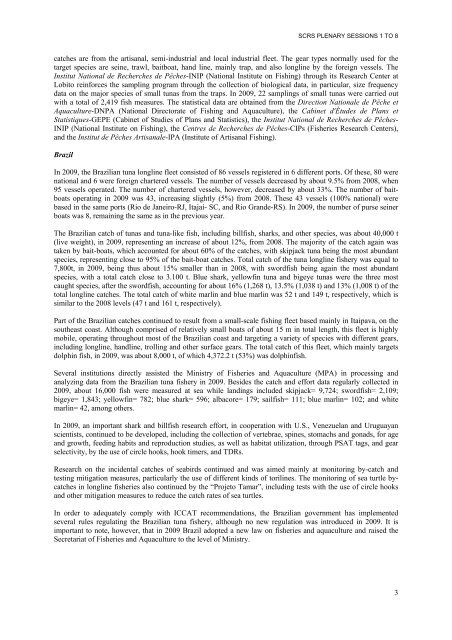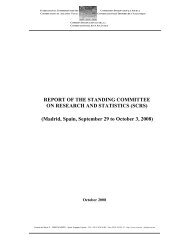REPORT OF THE STANDING COMMITTEE ON RESEARCH ... - Iccat
REPORT OF THE STANDING COMMITTEE ON RESEARCH ... - Iccat
REPORT OF THE STANDING COMMITTEE ON RESEARCH ... - Iccat
You also want an ePaper? Increase the reach of your titles
YUMPU automatically turns print PDFs into web optimized ePapers that Google loves.
SCRS PLENARY SESSI<strong>ON</strong>S 1 TO 8<br />
catches are from the artisanal, semi-industrial and local industrial fleet. The gear types normally used for the<br />
target species are seine, trawl, baitboat, hand line, mainly trap, and also longline by the foreign vessels. The<br />
Institut National de Recherches de Pêches-INIP (National Institute on Fishing) through its Research Center at<br />
Lobito reinforces the sampling program through the collection of biological data, in particular, size frequency<br />
data on the major species of small tunas from the traps. In 2009, 22 samplings of small tunas were carried out<br />
with a total of 2,419 fish measures. The statistical data are obtained from the Direction Nationale de Pêche et<br />
Aquaculture-DNPA (National Directorate of Fishing and Aquaculture), the Cabinet d'Études de Plans et<br />
Statistiques-GEPE (Cabinet of Studies of Plans and Statistics), the Institut National de Recherches de Pêches-<br />
INIP (National Institute on Fishing), the Centres de Recherches de Pêches-CIPs (Fisheries Research Centers),<br />
and the Institut de Pêches Artisanale-IPA (Institute of Artisanal Fishing).<br />
Brazil<br />
In 2009, the Brazilian tuna longline fleet consisted of 86 vessels registered in 6 different ports. Of these, 80 were<br />
national and 6 were foreign chartered vessels. The number of vessels decreased by about 9.5% from 2008, when<br />
95 vessels operated. The number of chartered vessels, however, decreased by about 33%. The number of baitboats<br />
operating in 2009 was 43, increasing slightly (5%) from 2008. These 43 vessels (100% national) were<br />
based in the same ports (Rio de Janeiro-RJ, Itajaí- SC, and Rio Grande-RS). In 2009, the number of purse seiner<br />
boats was 8, remaining the same as in the previous year.<br />
The Brazilian catch of tunas and tuna-like fish, including billfish, sharks, and other species, was about 40,000 t<br />
(live weight), in 2009, representing an increase of about 12%, from 2008. The majority of the catch again was<br />
taken by bait-boats, which accounted for about 60% of the catches, with skipjack tuna being the most abundant<br />
species, representing close to 95% of the bait-boat catches. Total catch of the tuna longline fishery was equal to<br />
7,800t, in 2009, being thus about 15% smaller than in 2008, with swordfish being again the most abundant<br />
species, with a total catch close to 3.100 t. Blue shark, yellowfin tuna and bigeye tunas were the three most<br />
caught species, after the swordfish, accounting for about 16% (1,268 t), 13.5% (1,038 t) and 13% (1,008 t) of the<br />
total longline catches. The total catch of white marlin and blue marlin was 52 t and 149 t, respectively, which is<br />
similar to the 2008 levels (47 t and 161 t, respectively).<br />
Part of the Brazilian catches continued to result from a small-scale fishing fleet based mainly in Itaipava, on the<br />
southeast coast. Although comprised of relatively small boats of about 15 m in total length, this fleet is highly<br />
mobile, operating throughout most of the Brazilian coast and targeting a variety of species with different gears,<br />
including longline, handline, trolling and other surface gears. The total catch of this fleet, which mainly targets<br />
dolphin fish, in 2009, was about 8,000 t, of which 4,372.2 t (53%) was dolphinfish.<br />
Several institutions directly assisted the Ministry of Fisheries and Aquaculture (MPA) in processing and<br />
analyzing data from the Brazilian tuna fishery in 2009. Besides the catch and effort data regularly collected in<br />
2009, about 16,000 fish were measured at sea while landings included skipjack= 9,724; swordfish= 2,109;<br />
bigeye= 1,843; yellowfin= 782; blue shark= 596; albacore= 179; sailfish= 111; blue marlin= 102; and white<br />
marlin= 42, among others.<br />
In 2009, an important shark and billfish research effort, in cooperation with U.S., Venezuelan and Uruguayan<br />
scientists, continued to be developed, including the collection of vertebrae, spines, stomachs and gonads, for age<br />
and growth, feeding habits and reproduction studies, as well as habitat utilization, through PSAT tags, and gear<br />
selectivity, by the use of circle hooks, hook timers, and TDRs.<br />
Research on the incidental catches of seabirds continued and was aimed mainly at monitoring by-catch and<br />
testing mitigation measures, particularly the use of different kinds of torilines. The monitoring of sea turtle bycatches<br />
in longline fisheries also continued by the “Projeto Tamar”, including tests with the use of circle hooks<br />
and other mitigation measures to reduce the catch rates of sea turtles.<br />
In order to adequately comply with ICCAT recommendations, the Brazilian government has implemented<br />
several rules regulating the Brazilian tuna fishery, although no new regulation was introduced in 2009. It is<br />
important to note, however, that in 2009 Brazil adopted a new law on fisheries and aquaculture and raised the<br />
Secretariat of Fisheries and Aquaculture to the level of Ministry.<br />
3

















